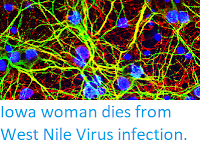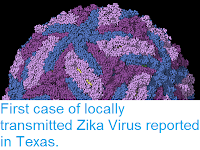The Pan American Health Organization has reported an outbreak of Measles in the municipality of Caroní in Bolivar State, Venezuela, with around 570 suspected cases, 217 of which have been confirmed, since the last week of August 2017. Around 76% of those affected are reported to be children under a year of age. The country is thought to have become vulnerable to the disease as the rate of vaccination has dropped over the past decade, as a political and economic turmoil in the country has led to both a shortage of the vaccine and the loss of many health workers, who have moved overseas to escape the country's problems. The outbreak has prompted a major drive by the World Health Organisation to obtain the vaccines and deliver them to vulnerable communities. Neighbouring countries are monitoring the epidemic carefully, due to concerns that the disease may spread across their borders.
Measles is a Viral Disease, that presents as a fever combined with a cough and inflamed eyes, followed by the development of a rash first in the mouth and then across the body. About 30% of cases go on to develop complications, which can include diarrhoea, blindness, inflammation of the brain and pneumonia, and the disease can be fatal. Measles is a highly infectious airborne disease spread by coughing, with un-immunised people living in close proximity to infected persons having an approximately 90% chance of catching the Virus. The disease is easily prevented by vaccination, but hard to treat once people are infected, with small children, who are least likely to have been immunised, particularly vulnerable. This makes it particularly important for health workers to be alert for new cases once the disease becomes established in an area, and ensure that all potential cases are screened for the Virus promptly.
Measles is caused by a single-strand RNA Virus belonging to the genus Morbillivirus, which also includes the Viruses that cause Canine Distemper and Rinderpest, as well as a variety of other diseases infecting domestic and wild Mammals. The genius Morbillivirus is in turn a member of the Paramyxoviridae, a group of Viruses that infect a wide range of Mammals, Birds, Reptiles and Fish, and includes the Virus that causes Mumps in Humans.
See also...
The approximate location of the area of the Bolivar Measles outbreak. Google Maps.
Measles is a Viral Disease, that presents as a fever combined with a cough and inflamed eyes, followed by the development of a rash first in the mouth and then across the body. About 30% of cases go on to develop complications, which can include diarrhoea, blindness, inflammation of the brain and pneumonia, and the disease can be fatal. Measles is a highly infectious airborne disease spread by coughing, with un-immunised people living in close proximity to infected persons having an approximately 90% chance of catching the Virus. The disease is easily prevented by vaccination, but hard to treat once people are infected, with small children, who are least likely to have been immunised, particularly vulnerable. This makes it particularly important for health workers to be alert for new cases once the disease becomes established in an area, and ensure that all potential cases are screened for the Virus promptly.
Thin-section transmission electron micrograph of a Measles Virus.
Measles is caused by a single-strand RNA Virus belonging to the genus Morbillivirus, which also includes the Viruses that cause Canine Distemper and Rinderpest, as well as a variety of other diseases infecting domestic and wild Mammals. The genius Morbillivirus is in turn a member of the Paramyxoviridae, a group of Viruses that infect a wide range of Mammals, Birds, Reptiles and Fish, and includes the Virus that causes Mumps in Humans.
See also...
Follow Sciency Thoughts on Facebook.








